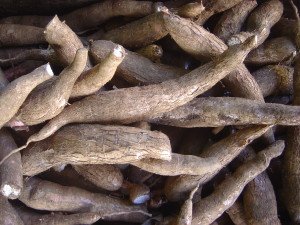Tapioca is produced from the starch of the cassava plant. Officially known as Tapioca starch, it differs from Cassava flour in that the Cassava flour is ground from the root itself.
The cassava plant has either red or green branches with blue spindles on them. The root of the green-branched variant requires treatment to remove linamarin, a cyanogenic glycoside occurring naturally in the plant, which otherwise may be converted into cyanide. Konzo (also called mantakassa) is a paralytic disease associated with several weeks of almost exclusive consumption of insufficiently processed bitter cassava.
In the North and Northeast of Brazil, traditional community based production of tapioca is a by-product of manioc flour production from cassava roots. In this process, the manioc (after treatment to remove toxicity) is ground to a pulp with a small hand- or diesel-powered mill. This masa is then squeezed to dry it out. The wet masa is placed in a long woven tube called a tipiti. The top of the tube is secured while a large branch or lever is inserted into a loop at the bottom and used to stretch the entire implement vertically, squeezing a starch-rich liquid out through the weave and ends. This liquid is collected and the water allowed to evaporate, leaving behind a fine-grained tapioca powder similar in appearance to corn starch.
Commercially, the starch is processed into several forms: hot soluble powder, meal, pre-cooked fine/coarse flakes, rectangular sticks, and spherical “pearls”. Pearls are the most widely available shape; sizes range from about 1 mm to 8 mm in diameter, with 2–3 mm being the most common.
Flakes, sticks, and pearls must be soaked well before cooking, in order to rehydrate, absorbing water up to twice their volume. After rehydration, tapioca products become leathery and swollen. Processed tapioca is usually white, but sticks and pearls may be colored. Since old times, the most common color applied to tapioca has been brown, but recently pastel colors have been available. Tapioca pearls are generally opaque when raw, but become translucent when cooked in boiling water: it forms a clear gel with long, slightly stringy texture. Moreover, tapioca flour loses most of its thickening properties with long cooking or in high acidic conditions.
Gluten free, it can be used by those who are gluten intolerant as in baked products it lends a springy texture, promotes browning and makes crispy crusts.
Brazil in South America, Thailand in Asia, and Nigeria in Africa are the world’s largest producers of cassava. Currently, Thailand accounts for about 60% of worldwide exports.
As for cassava has a worldwide cultivation, tapioca flour plays an obvious role in thickening products like pudding, starches and gravy. It plays a more subtle role in baked products like muffins, biscuits, and other baked goods. In fact, it is the preferred thickener for delicate foods and desserts, also producing a high gloss, and we can find tapioca flour in many different bakery product and recipes worldwide.
Click here to disclose the best tapioca flour recipe that Flour Academy staff chose for you!
Thanks to wikipedia.com for the information provided for this page




